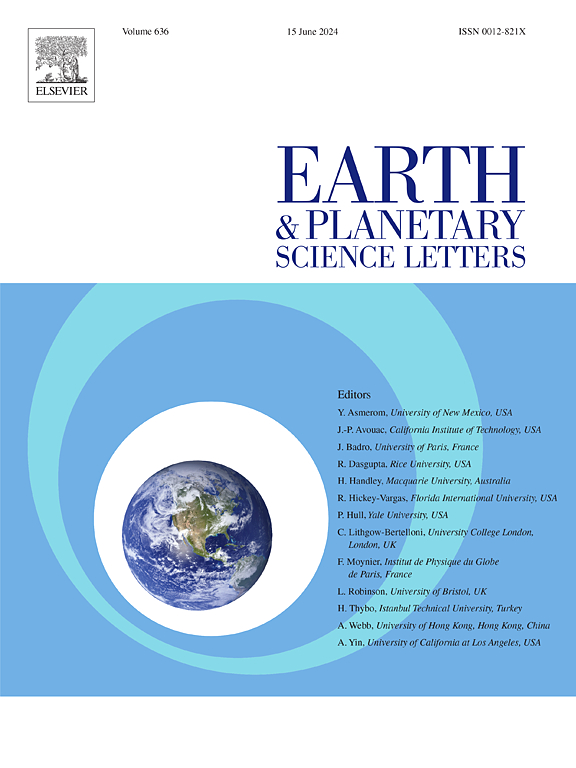利用钾同位素追踪岛弧成岩过程
IF 4.8
1区 地球科学
Q1 GEOCHEMISTRY & GEOPHYSICS
引用次数: 0
摘要
弧熔岩显示出明显的化学和同位素异质性,这主要是由于来自俯冲板块的再循环物质造成的。然而,不同类型的俯冲沉积物和大洋地壳对弧岩浆成岩作用的贡献程度,以及地幔楔和上覆地壳的作用仍存在争议。钾(K)同位素有可能为了解弧岩浆的形成过程和来源提供新的视角,因为沉积物和蚀变洋壳中的钾含量很高,而且与洋中脊玄武岩和上地幔相比,它们具有不同的δ41K值(-0.42 ± 0.08‰,2SD)。在这里,我们报告了环太平洋边缘32个特征明确的弧熔岩的K同位素组成。我们发现濑户内弧样品中的δ41K值很低(-0.86‰ ∼ -0.38‰),我们将其解释为同位素轻的沉积物融入弧下地幔的结果。库里尔弧和巴拿马弧熔岩的δ41K值很高(-0.36‰ ∼ 0.02‰),而且它们的δ41K值与Ba/Th比值呈正相关,表明有∼0.5-2%的脱水蚀变地壳流体加入。阿达克岩的钾同位素组成(-0.44‰ ∼ -0.01‰)多变,但总体偏重,与诊断性微量元素指标Sr/Y、La/Yb和K/U相关。这些结果表明,在热板块俯冲变质脱水和/或板块熔融前的流体变质过程中,K同位素分馏是有限的。我们的研究表明,源自俯冲沉积物和板块的流体和熔体对不同类型弧岩浆的起源产生了不同的影响,这证明了K同位素在研究弧岩浆成岩过程中的重要意义。本文章由计算机程序翻译,如有差异,请以英文原文为准。
Tracing island arc petrogenesis using potassium isotopes
Arc lavas display significant chemical and isotopic heterogeneity mainly due to recycled materials from subducting slabs. However, the extent to which different types of subducted sediments and oceanic crust contribute to the petrogenesis of arc magmas, as well as the roles of the mantle wedge and overlying crust, remain debated. Potassium (K) isotopes have the potential to provide new insights into the processes and sources of arc magmatism because sediments and altered oceanic crust are highly enriched in K and have distinct δ41K values compared with the mid-ocean ridge basalts and upper mantle (-0.42 ± 0.08‰, 2SD). Here we report K isotopic compositions of 32 well-characterized arc lavas from the circum-Pacific margins. We find low δ41K values (-0.86‰ ∼ -0.38‰) in the Setouchi arc samples, which we interpret as the result of incorporation of isotopically light sediments into the subarc mantle. The Kurile and Panama arc lavas have high δ41K values (-0.36‰ ∼ 0.02‰) and their δ41K values correlate positively with the Ba/Th ratios, indicating ∼0.5–2% fluid additions from dehydrated altered crust. Adakites have variable but overall heavy K isotope compositions (-0.44‰ ∼ -0.01‰) , which correlate with the diagnostic trace-element indicators of Sr/Y, La/Yb and K/U. These results indicate limited K isotope fractionation during metamorphic dehydration of hot slab subduction, and/or fluid metasomatism before the slab melting. Our study suggests that fluids and melts originating from subducting sediments and slabs exerted distinct influences on the origins of different types of arc magmas, demonstrating the significance of K isotopes in studying the petrogenesis of arc magmas.
求助全文
通过发布文献求助,成功后即可免费获取论文全文。
去求助
来源期刊

Earth and Planetary Science Letters
地学-地球化学与地球物理
CiteScore
10.30
自引率
5.70%
发文量
475
审稿时长
2.8 months
期刊介绍:
Earth and Planetary Science Letters (EPSL) is a leading journal for researchers across the entire Earth and planetary sciences community. It publishes concise, exciting, high-impact articles ("Letters") of broad interest. Its focus is on physical and chemical processes, the evolution and general properties of the Earth and planets - from their deep interiors to their atmospheres. EPSL also includes a Frontiers section, featuring invited high-profile synthesis articles by leading experts on timely topics to bring cutting-edge research to the wider community.
 求助内容:
求助内容: 应助结果提醒方式:
应助结果提醒方式:


